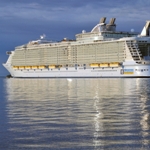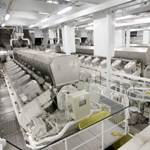Wärtsilä Powers Oasis of the Seas
 At the heart of Oasis of the Seas, the world’s largest passenger vessel, beneath an original carousel, an array of restaurants, surfing simulators, rock-climbing walls, a tropical living park and guests and crew on board, are two sets of three Wärtsilä engines, powering everything on the ship.
At the heart of Oasis of the Seas, the world’s largest passenger vessel, beneath an original carousel, an array of restaurants, surfing simulators, rock-climbing walls, a tropical living park and guests and crew on board, are two sets of three Wärtsilä engines, powering everything on the ship.
Today, STX Europe’s shipyard in Turku, Finland will officially hand over Oasis of the Seas to Royal Caribbean Cruises Ltd. (RCCL). The 360m long vessel is powered by Wärtsilä’s most modern, high technology equipment. Oasis of the Seas is equipped with a total of six Wärtsilä 46 engines, three 12-cylinder and three 16-cylinder engines, generating more than 96 MW. The vessel is also equipped with four 5.5 MW Wärtsilä bow thrusters, which are among the largest in the world.
 Wärtsilä’s engines are equipped with common rail technology, which provides an important and very visible advantage. As the combustion and other process parameters can be adjusted for lower load ranges, smoke emissions can be reduced. Wärtsilä continuously aims to improve the environmental performance of its products and solutions, with the main focus being on improving efficiency and minimizing emissions.
Wärtsilä’s engines are equipped with common rail technology, which provides an important and very visible advantage. As the combustion and other process parameters can be adjusted for lower load ranges, smoke emissions can be reduced. Wärtsilä continuously aims to improve the environmental performance of its products and solutions, with the main focus being on improving efficiency and minimizing emissions.
The Wärtsilä bow thrusters make the vessel easy to operate. They have a combined power output of 22 MW. In fact, the bow thrusters alone have more power than is installed on a normal cargo ship.
Propelling a vessel 360 m long, 65 ms wide and carrying up to 8,500 people – 2165 of them crew members – is no small achievement. The vessel’s air-conditioning systems, production of 50 tons of ice cubes each day, and heating the water in the 21 swimming pools and Jacuzzis, together consume several megawatts of power. As does carrying all the supplies needed for a seven-day cruise.
The engines are essentially a power plant that produces electricity, which is then used to run everything on board. The majority is used for propelling the vessel, but this floating holiday destination also has many other energy users. “After propulsion, air conditioning is next on the list of major onboard energy consumers,” says Fred Danska, Director, Cruise Business at Wärtsilä.






